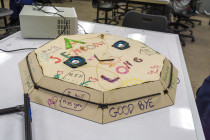Posts Tagged 'racheln'
Fabric Sensor: Soft Sensor
(link to our past documentation of this project) (code for this project can be found here) We designed a fabric sensor intended for the user to take one-word notes and send said notes as reminders to themselves. Our primary purpose
Fabric Sensor: Soft Sensor
(link to our past documentation of this project) (code for this project can be found here) We designed a fabric sensor intended for the user to take one-word notes and send said notes as reminders to themselves. Our primary purpose
Fabric Sensor Prototype
By Rachel Nakamura (rnakamur) and Joseph Paetz (rpaetz) We wanted to create a soft, fabric sensor that one could interact with to create reminders for later if one doesn’t have paper, pens, notebooks, or ways to record reminders immediately available. The idea of
Fabric Sensor Prototype
By Rachel Nakamura (rnakamur) and Joseph Paetz (rpaetz) We wanted to create a soft, fabric sensor that one could interact with to create reminders for later if one doesn’t have paper, pens, notebooks, or ways to record reminders immediately available. The idea of

One-in-one-out: “A Sensory So-Long”
Teaching children to say goodbye is frequent topic of discussion in parenting literature. One Harvard Medical School Professor, Susan Linn, says that, “[kids should know that] although no one can stop transitions, everyone has a chance to discover what you

One-in-one-out: “A Sensory So-Long”
Teaching children to say goodbye is frequent topic of discussion in parenting literature. One Harvard Medical School Professor, Susan Linn, says that, “[kids should know that] although no one can stop transitions, everyone has a chance to discover what you
Sensing Prototype: Collabright
Ninety percent of communication is nonverbal. Though everyday life is full of nonverbal communication such as traffic signals, morning alarms, and even facial expressions, people often find themselves unable to work as a team once they can no longer verbally speak
Sensing Prototype: Collabright
Ninety percent of communication is nonverbal. Though everyday life is full of nonverbal communication such as traffic signals, morning alarms, and even facial expressions, people often find themselves unable to work as a team once they can no longer verbally speak
